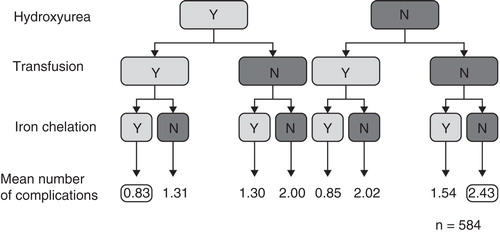Figures & data
Table 1. Clinical requirements for occasional, intermittent or chronic transfusions in patients with β-thalassemia.
Table 2. Management options for specific β-thalassemia complications.
Figure 2. Major complications observed in patients with either transfusion-dependent or non-transfusion-dependent β-thalassemia. Patients with β-thalassemia intermedia or HbE/β-thalassemia exhibit a unique profile of complications compared with those with β-thalassemia major, although several complications including osteoporosis, endocrinopathies and hepatic complications, are observed across all patient types.

Figure 3. Flow chart depicting the mean number of complications that occurred in patients with β-thalassemia intermedia undergoing different management schemes. Numbers reported are mean incidences for the 584 patients included in the retrospective OPTIMAL CARE study, according to the management strategy applied that may have involved hydroxyurea, red blood cell transfusion and iron chelation.

Table 3. Frequency and relative expense of observation strategies for monitoring iron overload and other complications in β-thalassemias.

